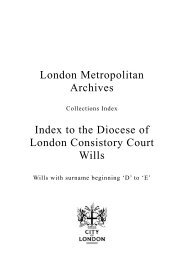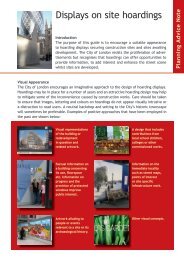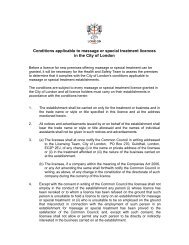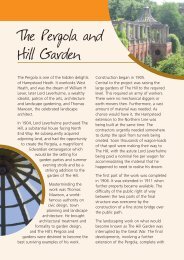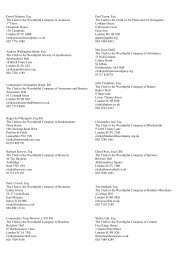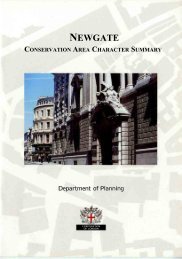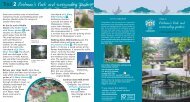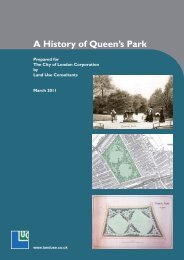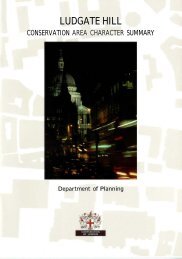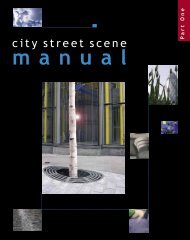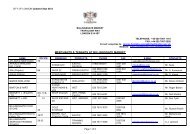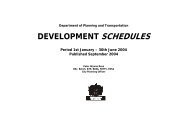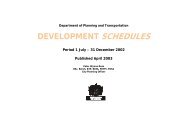Burnham Beeches Management Plan 2010 - the City of London ...
Burnham Beeches Management Plan 2010 - the City of London ...
Burnham Beeches Management Plan 2010 - the City of London ...
Create successful ePaper yourself
Turn your PDF publications into a flip-book with our unique Google optimized e-Paper software.
1.1.2 Location<br />
<strong>Burnham</strong> <strong>Beeches</strong> is in south Buckinghamshire,<br />
in <strong>the</strong> parish <strong>of</strong> <strong>Burnham</strong>, and is next to Farnham<br />
Common village. It covers 220 hectares.<br />
1.2 Ownership & Access Rights<br />
<strong>Burnham</strong> <strong>Beeches</strong> is owned by <strong>the</strong> <strong>City</strong> <strong>of</strong><br />
<strong>London</strong> which acquired it in several parts from<br />
1880 onwards.<br />
<strong>Burnham</strong> <strong>Beeches</strong> has no formally designated<br />
public rights <strong>of</strong> way but <strong>the</strong> <strong>City</strong> <strong>of</strong> <strong>London</strong>’s<br />
Open Spaces Act (1878) allows access on foot to<br />
all areas <strong>of</strong> <strong>the</strong> <strong>City</strong>’s open spaces, by all persons<br />
at all times. In <strong>Burnham</strong> <strong>Beeches</strong> access is<br />
subject to <strong>the</strong> byelaws as given on <strong>the</strong> notice<br />
boards on site. These ensure that visitors do not<br />
cause damage to <strong>the</strong> <strong>Beeches</strong> and do not<br />
adversely affect <strong>the</strong> enjoyment <strong>of</strong> o<strong>the</strong>rs. Horse<br />
riding and cycling are permitted on tarmac roads.<br />
Under <strong>the</strong> Countryside Rights <strong>of</strong> Way (Crow) Act<br />
2000 it is considered to be section 15 land (i.e. it<br />
was already designated as open access land).<br />
1.3 Site Status<br />
<strong>Burnham</strong> <strong>Beeches</strong> was registered as Common<br />
111 in 1967 under <strong>the</strong> 1968 Commons<br />
Registration Act. A Common has an owner but is<br />
<strong>of</strong>ten also used by o<strong>the</strong>r people who have<br />
common rights, for example to graze animals or<br />
cut wood. There are however, no commoners<br />
for <strong>Burnham</strong> <strong>Beeches</strong>.<br />
1 Site Description<br />
<strong>Burnham</strong> <strong>Beeches</strong> has been a Site <strong>of</strong> Special<br />
Scientific Interest (SSSI) since 1951 and a<br />
National Nature Reserve since 1993. In 2005 <strong>the</strong><br />
<strong>Beeches</strong> was designated as a Special Area <strong>of</strong><br />
Conservation (SAC), for its beech forests on acid<br />
soils. The citation acknowledges <strong>the</strong> mosses,<br />
lichens, insects and o<strong>the</strong>r invertebrates that<br />
depend on <strong>the</strong> ancient trees. The SSSI citation<br />
also mentions <strong>the</strong> heathland and valley mire<br />
systems that are also considered integral to <strong>the</strong><br />
character <strong>of</strong> <strong>the</strong> <strong>Beeches</strong>. <strong>Burnham</strong> <strong>Beeches</strong> is,<br />
<strong>the</strong>refore, an important nature reserve in<br />
European terms; this confers both obligations<br />
and enhanced protection.<br />
The boundary <strong>of</strong> <strong>the</strong> SSSI and SAC site is not <strong>the</strong><br />
same as <strong>the</strong> <strong>City</strong> <strong>of</strong> <strong>London</strong> boundary for <strong>the</strong><br />
reserve. Swilly Pond was omitted (probably in<br />
error) but a considerable area <strong>of</strong> land belonging<br />
to <strong>the</strong> Portman-Burtley Estate and <strong>the</strong> National<br />
Trust was included.<br />
1.4 Physical Features<br />
The landscape potential <strong>of</strong> an area is ultimately<br />
determined by <strong>the</strong> combination <strong>of</strong> soils,<br />
drainage and topography found <strong>the</strong>re. The<br />
<strong>Beeches</strong> has a complex geology.<br />
It lies on <strong>the</strong> Winter Hill gravel terrace; <strong>the</strong><br />
surface layers consist <strong>of</strong> material left by melt<br />
water – rivers coming from <strong>the</strong> glaciers <strong>of</strong> <strong>the</strong><br />
last Ice Age. These rivers, made up <strong>of</strong> many<br />
small shallow channels, flowed across <strong>the</strong> whole<br />
area and left stones and sand ranging from fine<br />
silt particles to large pebbles.<br />
The result is patches <strong>of</strong> almost pure sand, pure<br />
clay and gravels <strong>of</strong> different sizes all occurring<br />
close toge<strong>the</strong>r.<br />
Fine dust blown <strong>of</strong>f <strong>the</strong> glaciers collected in<br />
hollows, including those created by melting ice<br />
blocks, and in time this became patches <strong>of</strong> loess<br />
(fine clay and mineral) soils.<br />
The whole region was <strong>the</strong>n cut through by <strong>the</strong><br />
River Thames, <strong>the</strong> course <strong>of</strong> which has moved<br />
south several times, from originally being north<br />
<strong>of</strong> <strong>Burnham</strong> <strong>Beeches</strong> to its current position to<br />
<strong>the</strong> south. Each move south cut a new river<br />
terrace leaving ‘steps’ in <strong>the</strong> landscape which<br />
can be seen today.<br />
Under <strong>the</strong> glacial surface deposits are <strong>the</strong> old<br />
Reading beds (a different type <strong>of</strong> sand and<br />
gravel) deriving from <strong>the</strong> estuary <strong>of</strong> <strong>the</strong> Thames.<br />
Under this is older chalk, formed when <strong>the</strong> area<br />
was a shallow sea. This chalk comes close to <strong>the</strong><br />
surface along <strong>Burnham</strong> Walk/Victoria Drive.<br />
The topography <strong>of</strong> <strong>the</strong> <strong>Beeches</strong> includes two<br />
shallow valleys. One has <strong>the</strong> major stream, mire<br />
and pond system in it, <strong>the</strong> o<strong>the</strong>r is drier and<br />
steeper sided with swallow holes along its<br />
length.<br />
The soils are generally thin, free draining and<br />
acidic (pH2.8-7.0). In areas such as in <strong>the</strong> less<br />
disturbed woodland <strong>the</strong> organic layers are<br />
thicker. In various places an iron pan has<br />
developed, impeding drainage and allowing <strong>the</strong><br />
build up <strong>of</strong> peaty soils.<br />
7



